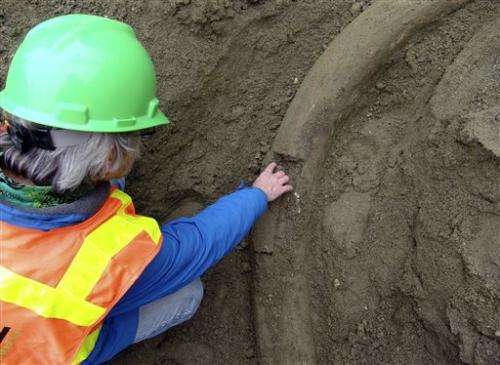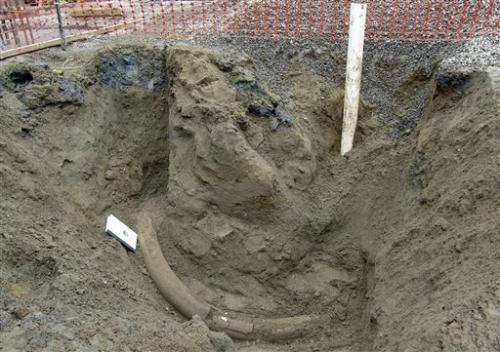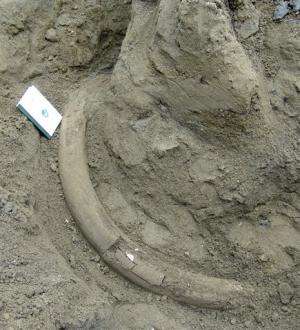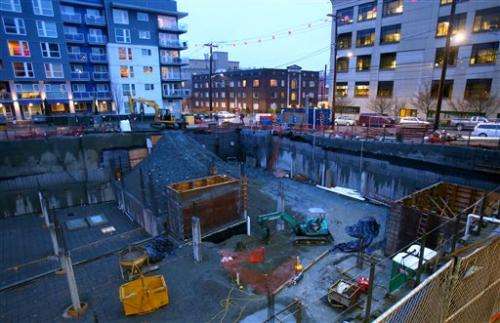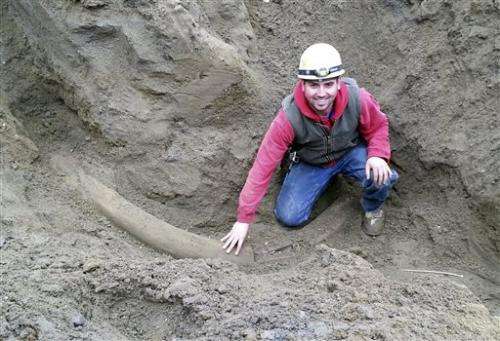This image provided by the Burke Museum and taken on Tuesday, Feb. 11, 2014, Bruce Crowley, the museum's Preparator for the Paleontology Division, examines what museum officials believe is mammoth tusk that was uncovered by construction workers in the south Lake Union area of Seattle. According to the museum, the ancient elephant relatives lived in Washington until approximately 10,000 years ago and their fossils have been found throughout western Washington. (AP Photo/Burke Museum)
Paleontologists from the University of Washington hope to move an ice age mammoth tusk uncovered in a Seattle neighborhood to a museum on campus.
Christian Sidor (SEE'-door) of the Burke Museum says carbon dating could provide a better picture of the time about 10,000 years ago when the ancient elephant relative followed the retreating, 3,000-foot ice layer.
The tusk is very rare, but similar tusks and mammoth teeth found in Washington have made the Columbian mammoth the state fossil.
Workers with Transit Plumbing were excavating a construction site Tuesday in the city's South Lake Union area when they hit something hard and uncovered the tusk. Owner Jeff Estep says they stopped work and called the experts.
The museum is awaiting approval from the property owner to start removing the tusk.
This image provided by the Burke Museum and taken on Tuesday, Feb. 11, 2014, shows what museum officials believe is mammoth tusk that was uncovered by construction workers in the south Lake Union area of Seattle. According to the museum, the ancient elephant relatives lived in Washington until approximately 10,000 years ago and their fossils have been found throughout western Washington. (AP Photo/Burke Museum)
This image provided by the Burke Museum and taken on Tuesday, Feb. 11, 2014, shows what museum officials believe is mammoth tusk that was uncovered by construction workers in the south Lake Union area of Seattle. According to the museum, the ancient elephant relatives lived in Washington until approximately 10,000 years ago and their fossils have been found throughout western Washington. (AP Photo/Burke Museum) The construction site where a wooly mammoth tusk was discovered is shown on Tuesday, February 11, 2014. The construction site is adjacent to the Bright Horizons Childcare and Early Learning facility in Seattle's South Lake Union neighborhood in the downtown core of the city. The Burke Museum confirmed that the ancient find is a mammoth tusk. (Associated Press/seattlepi.com, Joshua Trujillo) This image provided by Transit Plumbing and taken on Tuesday, Feb. 11, 2014, shows plumber apprentice Joe Wells touching what Burke Museum officials believe is mammoth tusk that was uncovered by construction workers in the south Lake Union area of Seattle. According to the museum, the ancient elephant relatives lived in Washington until approximately 10,000 years ago and their fossils have been found throughout western Washington. (AP Photo/Transit Plumbing)
© 2014 The Associated Press. All rights reserved.
